1. Leung DY, Bieber T. Atopic dermatitis. Lancet. 2003; 361:151–160. PMID:
12531593.

2. Weidinger S, Novak N. Atopic dermatitis. Lancet. 2016; 387:1109–1122. PMID:
26377142.

3. van Beijsterveldt CE, Boomsma DI. Genetics of parentally reported asthma, eczema and rhinitis in 5-yr-old twins. Eur Respir J. 2007; 29:516–521. PMID:
17215318.

4. Spergel JM. From atopic dermatitis to asthma: the atopic march. Ann Allergy Asthma Immunol. 2010; 105:99–106. PMID:
20674819.

5. Stone SP, Muller SA, Gleich GJ. IgE levels in atopic dermatitis. Arch Dermatol. 1973; 108:806–811. PMID:
4764707.

6. Esparza-Gordillo J, Weidinger S, Fölster-Holst R, Bauerfeind A, Ruschendorf F, Patone G, et al. A common variant on chromosome 11q13 is associated with atopic dermatitis. Nat Genet. 2009; 41:596–601. PMID:
19349984.

7. Hirota T, Takahashi A, Kubo M, Tsunoda T, Tomita K, Sakashita M, et al. Genome-wide association study identifies eight new susceptibility loci for atopic dermatitis in the Japanese population. Nat Genet. 2012; 44:1222–1226. PMID:
23042114.

8. Schaarschmidt H, Ellinghaus D, Rodríguez E, Kretschmer A, Baurecht H, Lipinski S, et al. A genome-wide association study reveals 2 new susceptibility loci for atopic dermatitis. J Allergy Clin Immunol. 2015; 136:802–806. PMID:
25865352.

9. Sun LD, Xiao FL, Li Y, Zhou WM, Tang HY, Tang XF, et al. Genome-wide association study identifies two new susceptibility loci for atopic dermatitis in the Chinese Han population. Nat Genet. 2011; 43:690–694. PMID:
21666691.
10. Paternoster L, Standl M, Chen CM, Ramasamy A, Bønnelykke K, Duijts L, et al. Meta-analysis of genome-wide association studies identifies three new risk loci for atopic dermatitis. Nat Genet. 2011; 44:187–192. PMID:
22197932.
11. Paternoster L, Standl M, Waage J, Baurecht H, Hotze M, Strachan DP, et al. Multi-ancestry genome-wide association study of 21,000 cases and 95,000 controls identifies new risk loci for atopic dermatitis. Nat Genet. 2015; 47:1449–1456. PMID:
26482879.

12. Capon F, Di Meglio P, Szaub J, Prescott NJ, Dunster C, Baumber L, et al. Sequence variants in the genes for the interleukin-23 receptor (
IL23R) and its ligand (
IL12B) confer protection against psoriasis. Hum Genet. 2007; 122:201–206. PMID:
17587057.
13. Cheong HS, Kim LH, Park BL, Choi YH, Park HS, Hong SJ, et al. Association analysis of interleukin 5 receptor alpha subunit (
IL5RA) polymorphisms and asthma. J Hum Genet. 2005; 50:628–634. PMID:
16217591.
14. Christensen U, Haagerup A, Binderup HG, Vestbo J, Kruse TA, Børglum AD. Family based association analysis of the
IL2 and
IL15 genes in allergic disorders. Eur J Hum Genet. 2006; 14:227–235. PMID:
16333313.
15. Hanifin JM, Rajka G. Diagnostic features of atopic dermatitis. Acta Derm Venereol Suppl (Stockh). 1980; 92:44–47.
16. Kunz B, Oranje AP, Labrèze L, Stalder JF, Ring J, Taïeb A. Clinical validation and guidelines for the SCORAD index: consensus report of the European Task Force on Atopic Dermatitis. Dermatology. 1997; 195:10–19.

17. Asher MI, Keil U, Anderson HR, Beasley R, Crane J, Martinez F, et al. International Study of Asthma and Allergies in Childhood (ISAAC): rationale and methods. Eur Respir J. 1995; 8:483–491. PMID:
7789502.

18. Bush WS, Moore JH. Chapter 11: Genome-wide association studies. PLOS Comput Biol. 2012; 8:e1002822. PMID:
23300413.

19. Kraft P, Zeggini E, Ioannidis JP. Replication in genome-wide association studies. Stat Sci. 2009; 24:561–573. PMID:
20454541.

20. Ellinghaus D, Baurecht H, Esparza-Gordillo J, Rodríguez E, Matanovic A, Marenholz I, et al. High-density genotyping study identifies four new susceptibility loci for atopic dermatitis. Nat Genet. 2013; 45:808–812. PMID:
23727859.

21. Geng S, Gao S, Hu H, Hu Y, Yu S, Zhao S. The differentiation and clinical significance of follicular helper T cells during acute exacerbation in asthma patients. Xi Bao Yu Fen Zi Mian Yi Xue Za Zhi. 2015; 31:1383–1386. PMID:
26429540.
22. Jin H, Oyoshi MK, Le Y, Bianchi T, Koduru S, Mathias CB, et al.
IL-21R is essential for epicutaneous sensitization and allergic skin inflammation in humans and mice. J Clin Invest. 2009; 119:47–60. PMID:
19075398.
23. Mizutani H, Tamagawa-Mineoka R, Nakamura N, Masuda K, Katoh N. Serum
IL-21 levels are elevated in atopic dermatitis patients with acute skin lesions. Allergol Int. 2017; 66:440–444. PMID:
27884624.
24. Lin PY, Jen HY, Chiang BL, Sheu F, Chuang YH. Interleukin-21 suppresses the differentiation and functions of T helper 2 cells. Immunology. 2015; 144:668–676. PMID:
25351608.

25. Tamagawa-Mineoka R, Kishida T, Mazda O, Katoh N.
IL-21 reduces immediate hypersensitivity reactions in mouse skin by suppressing mast cell activation or IgE production. J Invest Dermatol. 2011; 131:1513–1520. PMID:
21430699.
26. Wood N, Bourque K, Donaldson DD, Collins M, Vercelli D, Goldman SJ, et al.
IL-21 effects on human IgE production in response to
IL-4 or
IL-13. Cell Immunol. 2004; 231:133–145. PMID:
15919378.
27. Esparza-Gordillo J, Schaarschmidt H, Liang L, Cookson W, Bauerfeind A, Lee-Kirsch MA, et al. A functional
IL-6 receptor (
IL6R) variant is a risk factor for persistent atopic dermatitis. J Allergy Clin Immunol. 2013; 132:371–377. PMID:
23582566.
28. Namkung JH, Lee JE, Kim E, Kim HJ, Seo EY, Jang HY, et al. Association of polymorphisms in genes encoding
IL-4,
IL-13 and their receptors with atopic dermatitis in a Korean population. Exp Dermatol. 2011; 20:915–919. PMID:
21913997.
29. Furue M. Atopic dermatitis--immunological abnormality and its background. J Dermatol Sci. 1994; 7:159–168. PMID:
7918234.

30. Trzeciak M, Gleń J, Rębała K, Bandurski T, Sikorska M, Nowicki R. Coexistence of 2282del4
FLG gene mutation and
IL-18 -137G/C gene polymorphism enhances the risk of atopic dermatitis. Postepy Dermatol Alergol. 2016; 33:57–62. PMID:
26985181.
31. Wu YY, Tang JP, Liu Q, Zheng XD, Fang L, Yin XY, et al. Scanning indels in the 5q22.1 region and identification of the
TMEM232 susceptibility gene that is associated with atopic dermatitis in the Chinese Han population. Gene. 2017; 617:17–23. PMID:
28351738.
32. Gould HJ, Sutton BJ. IgE in allergy and asthma today. Nat Rev Immunol. 2008; 8:205–217. PMID:
18301424.

33. Moffatt MF, Gut IG, Demenais F, Strachan DP, Bouzigon E, Heath S, et al. A large-scale, consortium-based genomewide association study of asthma. N Engl J Med. 2010; 363:1211–1221. PMID:
20860503.

34. Hoaglin DC. Misunderstandings about Q and ‘Cochran's Q test’ in meta-analysis. Stat Med. 2016; 35:485–495. PMID:
26303773.
35. Espinoza JL, Takami A, Nakata K, Onizuka M, Kawase T, Akiyama H, et al. A genetic variant in the
IL-17 promoter is functionally associated with acute graft-versus-host disease after unrelated bone marrow transplantation. PLoS One. 2011; 6:e26229. PMID:
22028838.
36. Liu XK, Lin X, Gaffen SL. Crucial role for nuclear factor of activated T cells in T cell receptor-mediated regulation of human interleukin-17. J Biol Chem. 2004; 279:52762–52771. PMID:
15459204.

37. Eskandari-Nasab E, Moghadampour M, Tahmasebi A. Meta-analysis of risk association between interleukin-17A and F gene polymorphisms and inflammatory diseases. J Interferon Cytokine Res. 2017; 37:165–174. PMID:
28186427.

38. Resende EP, Todo-Bom A, Loureiro C, Mota Pinto A, Oliveiros B, Mesquita L, et al. Asthma and rhinitis have different genetic profiles for
IL13,
IL17A and GSTP1 polymorphisms. Rev Port Pneumol (2006). 2017; 23:10–16. PMID:
27561723.
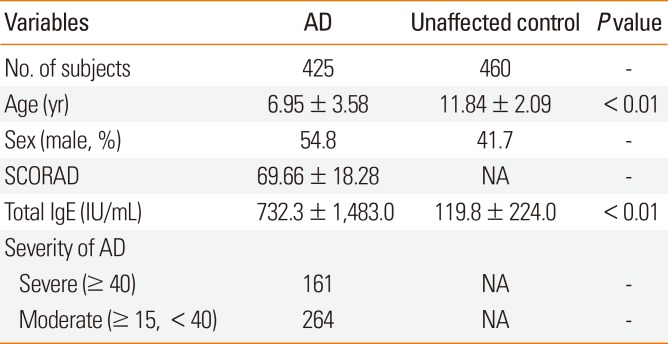
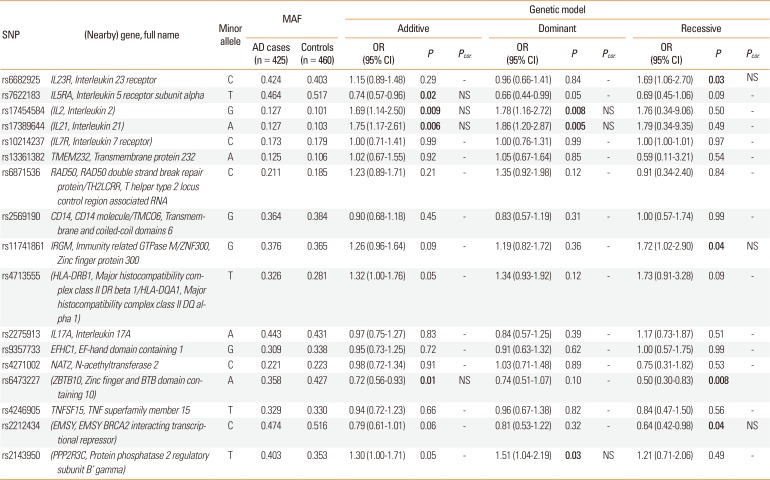
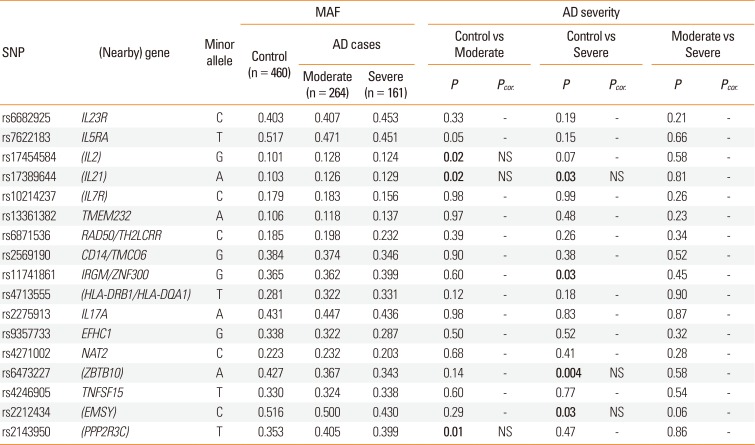
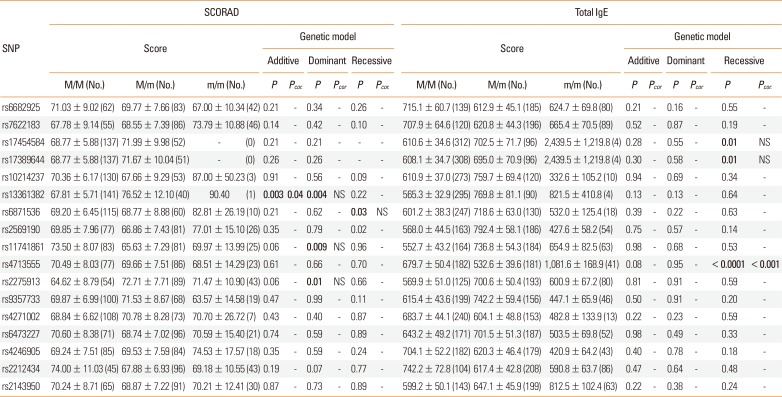
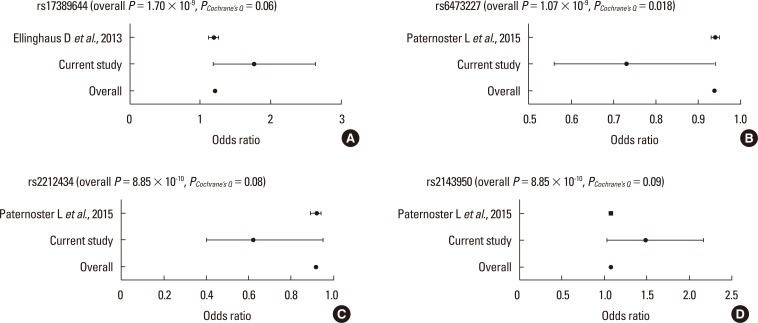




 PDF
PDF ePub
ePub Citation
Citation Print
Print



 XML Download
XML Download